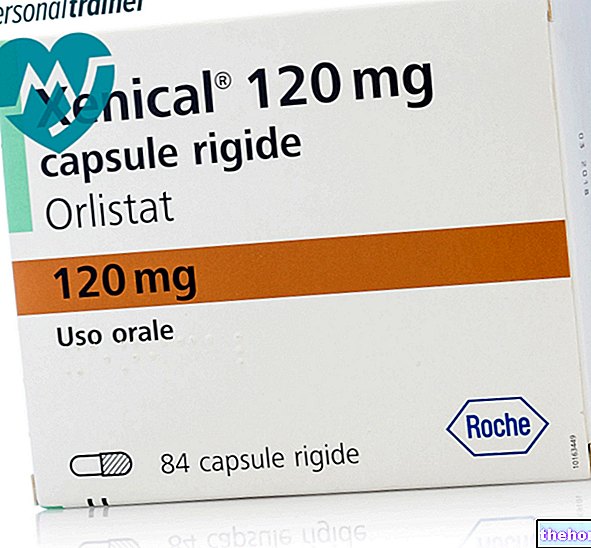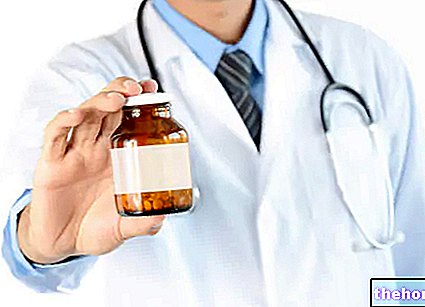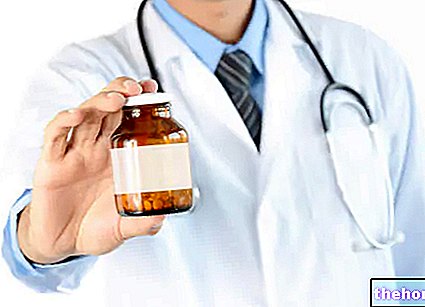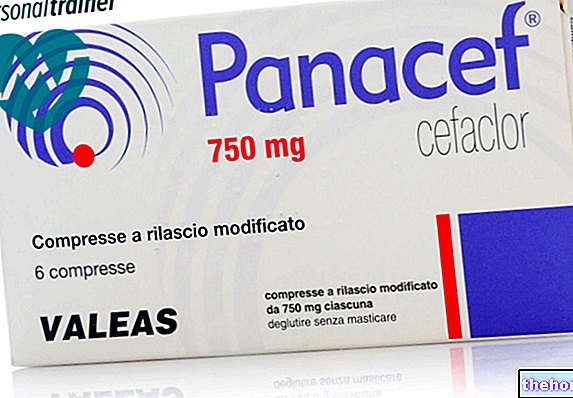Active ingredients: Urapidil
EBRANTIL 50 mg / 10 ml solution for injection for intravenous use and for infusion
Why is Ebrantil used? What is it for?
EBRANTIL is a blood pressure lowering medicine based on urapidil.
It is used in adults to treat hypertensive emergencies and emergencies.
Contraindications When Ebrantil should not be used
You will not be given EBRANTIL
- if you are allergic to urapidil or any of the other ingredients of this medicine (listed in section 6).
- If you are pregnant and breastfeeding (see section 2 "Pregnancy and breastfeeding").
- If you suffer from a narrowing of the aorta, the largest artery in the body (aortic stenosis of the isthmus) or have communication between an artery and a vein (arteriovenous shunt).
Precautions for use What you need to know before taking Ebrantil
Talk to your doctor or nurse before you are given EBRANTIL.
Tell your doctor if you have any of the following conditions:
- if you have already been given another medicine to lower your blood pressure before and there is not enough time for the effect to occur,
- if you have a weakening of the heart's activity due to functional damage of mechanical origin (eg stenosis of the aortic or mitral valve), if you have an obstruction of the pulmonary artery, the vessel that carries blood from the heart to the lungs (embolism lung) or a disease of the sac that lines the heart (pericardium)
- if you suffer from liver disease
- if you have moderate to severe kidney disease
- if you are an elderly person
- if you are taking cimetidine, a medicine to treat stomach lesions (ulcers see section 2 "Other medicines and EBRANTIL")
- if you have suffered a blow to the head (head injury)
Children and adolescents
EBRANTIL should be administered with caution to children and adolescents.
Interactions Which drugs or foods can change the effect of Ebrantil
Tell your doctor if you are taking, have recently taken or might take any other medicines, especially:
- medicines to lower high blood pressure (alpha-adrenergic receptor blockers, vasodilators, other antihypertensive drugs given at the same time, ACE inhibitors)
- cimetidine, a medicine to treat ulcers.
EBRANTIL with alcohol
Concomitant use with alcohol may enhance the antihypertensive action of EBRANTIL.
Warnings It is important to know that:
Pregnancy, breastfeeding and fertility
If you are pregnant or breast-feeding, think you may be pregnant or are planning to have a baby, ask your doctor for advice before being given this medicine. EBRANTIL will only be administered in pregnancy when strictly necessary, as there is insufficient experience in humans.
EBRANTIL should not be administered during breastfeeding.
Driving and using machines
EBRANTIL may affect the ability to drive, to use machines. This is particularly true at the start of treatment, when changing the product or when taking it in combination with alcohol (see section 2 EBRANTIL with alcohol).
EBRANTIL contains sodium and propylene glycol
EBRANTIL contains 4.358 mg of sodium per vial. To be taken into consideration in people with reduced kidney function or who follow a low sodium diet.
EBRANTIL contains propylene glycol. It can cause symptoms similar to those caused by alcohol.
Dose, Method and Time of Administration How to use Ebrantil: Posology
This medicine will be given to you into a vein (intravenously) under strict medical supervision. If in doubt, consult your doctor.
The dose for controlled lowering of blood pressure during and after surgery will be determined by your doctor.
The treatment will last for a maximum of 7 days. After this time, your doctor may prescribe medicines to lower your blood pressure to take by mouth.
Senior citizens
If you are elderly, your doctor will give you lower doses, at least at the beginning of therapy.
Patients with kidney and / or liver disease
If you have kidney and / or liver disease your doctor may give you lower doses
Use in children and adolescents
EBRANTIL is not usually given to children and adolescents. If necessary, the dose for the controlled reduction of blood pressure during and after surgery will be determined by the doctor.
If you stop taking EBRANTIL
If you have any further questions on the use of this medicine, ask your doctor or nurse.
Overdose What to do if you have taken too much Ebrantil
In case of accidental ingestion / intake of an excessive dose of EBRANTIL, the doctor will adopt the most suitable therapy.
If you are given high doses of EBRANTIL, you may experience:
- dizziness,
- low blood pressure when standing,
- fainting,
- fatigue and reduced reaction speed.
Side Effects What are the side effects of Ebrantil
Like all medicines, this medicine can cause side effects, although not everybody gets them.
Many of the following side effects are due to a sudden drop in blood pressure, but experience has disappeared within a few minutes, even during the fast infusion. In relation to the severity of the undesirable effects, however, a discontinuation of treatment should also be considered.
Common (may affect up to 1 in 10 patients)
- nausea,
- dizziness,
- headache
Uncommon (may affect up to 1 in 100 patients)
- sensation of feeling one's heartbeat (palpitations),
- fast heart beats (tachycardia),
- slow heartbeats (bradycardia),
- feeling of pressure or pain in the chest (symptoms similar to angina pectoris) and shortness of breath (dyspnoea),
- He retched,
- fatigue, weakness (asthenia),
- irregular heartbeats,
- increased sweating,
- decrease in blood pressure by changing posture, eg. standing up (orthostatic dysregulation)
Rare (may affect up to 1 in 1,000 patients)
- persistent and painful erection (priapism),
- stuffy nose (nasal congestion),
- allergic reactions such as itching, redness of the skin, skin rash with pustules, blisters and blisters (rash)
Very rare (may affect up to 1 in 10,000 patients)
- reduction in the number of platelets in the blood,
- agitation,
- sleep disorders,
- increased urge to urinate or worsening inability to hold urine (urinary incontinence), nocturnal enuresis (loss of urine during sleep)
Frequency not known (frequency cannot be estimated from the available data)
- swelling of the face, mouth, tongue, throat, but also of other mucous membranes (angioedema)
- itchy skin rash (hives)
Reporting of side effects
If you get any side effects, talk to your doctor or pharmacist. This includes any possible side effects not listed in this leaflet. You can also report side effects directly via the national reporting site at www.agenziafarmaco.gov.it/it/responsabili. By reporting side effects you can help provide more information on the safety of this medicine.
Expiry and Retention
Keep this medicine out of the sight and reach of children.
Do not use this medicine after the expiry date which is stated on the label after EXP. The expiry date refers to the last day of that month.
Do not store above 30 ° C.
Keep the ampoules in the outer carton to protect the medicine from light.
Solutions for continuous intravenous infusion must be prepared at the time of use. Any residues must not be reused.
Do not throw any medicines via wastewater or household waste. Ask your pharmacist how to throw away medicines you no longer use. This will help protect the environment.
Deadline "> Other information
What EBRANTIL contains
- The active ingredient is urapidil. Each vial contains 50 mg of urapidil.
- The other ingredients are propylene glycol, monobasic sodium phosphate dihydrate, monobasic sodium phosphate monohydrate, water for injections (see section 2 "EBRANTIL contains sodium and propylene glycol).
What EBRANTIL looks like and contents of the pack
EBRANTIL is presented as a solution for injection for intravenous use and for infusion.
It is available in packs of 5 vials of 10 ml
Source Package Leaflet: AIFA (Italian Medicines Agency). Content published in January 2016. The information present may not be up-to-date.
To have access to the most up-to-date version, it is advisable to access the AIFA (Italian Medicines Agency) website. Disclaimer and useful information.
01.0 NAME OF THE MEDICINAL PRODUCT -
EBRANTIL.
02.0 QUALITATIVE AND QUANTITATIVE COMPOSITION -
One 10 ml ampoule contains: (active ingredient) urapidil hydrochloride 54.70 mg (equivalent to 50 mg of urapidil).
For the full list of excipients, see section 6.1.
03.0 PHARMACEUTICAL FORM -
Solution for injection for intravenous use and for infusion.
04.0 CLINICAL INFORMATION -
04.1 Therapeutic indications -
Hypertensive emergencies and emergencies.
04.2 Posology and method of administration -
The solution for injection Ebrantil can be administered intravenously as a bolus or by continuous infusion in a supine patient.
Unless otherwise prescribed by a doctor, both single or repeated bolus administration as well as continuous intravenous infusion are possible in the proposed indications. It is possible to switch from acute parenteral therapy to maintenance therapy using oral hypotensive agents.
For the "intravenous bolus injection 10-50 mg of Ebrantil can be administered. The hypotensive action usually occurs within 5-10 minutes. The injection of Ebrantil can be repeated in relation to the trend in blood pressure, according to the dosage schedule reported below.
For the "continuous intravenous infusion dilute 200-250 mg of Ebrantil (4-5 ampoules of Ebrantil 50mg / 10ml solution for injection) in 500ml of a compatible infusion solution: physiological saline, 5 or 10% glucose solution, 5% levulose solution, dextran 40 solution with 0.9% sodium chloride. The maximum compatible concentration of Ebrantil per ml is 4 mg.
The infusion rate of the starting dose should not exceed 2 mg / min. The maintenance dose (on average 9 mg / h) and the duration of the infusion (no more than 7 days) should be adapted appropriately to the blood pressure response.
The extent of the reduction in blood pressure is determined by the dose infused over the first 15 minutes. Thereafter, stabilization of blood pressure can be achieved with considerably lower doses.
The infusion solution for maintaining the blood pressure level obtained by bolus injection is prepared as follows. In 500 ml of a compatible solution for infusion: physiological solution, 5 or 10% glucose solution, 5% levulose solution, dextran 40 solution with 0.9% sodium chloride, are generally diluted 100-200 mg of Ebrantil (2-4 ampoules of Ebrantil 50mg / 10ml solution for injection).
The maximum compatible concentration is 4 mg of Ebrantil per ml of solution for infusion. When the perfusor is used to administer the maintenance dose, 20 ml of Ebrantil equal to 100 mg of active ingredient is placed in a perfusor syringe and diluted to a volume of 50 ml with a compatible solution for infusion (see above) .
Controlled reduction of blood pressure in hypertensive patients during and after surgery:
Duration of treatment: no more than 7 days.
Specific patient groups
In older patients, antihypertensive drugs should be used with caution and initially in lower doses, since in these patients the sensitivity towards preparations of this kind is often changed. The pediatric indications of Ebrantil solution for injection for intravenous use are extremely rare. and therefore the cases in this regard are still limited.
In patients with impaired renal and / or hepatic function it may be necessary to reduce the dosage.
04.3 Contraindications -
Ebrantil is contraindicated:
- in case of hypersensitivity to the active substance or to any of the excipients;
- in pregnancy and in the period of lactation as there are not enough experiences in man up to now (see point 4.6 "Pregnancy and breastfeeding');
- in patients with aortic stenosis of the isthmus or with arteriovenous shunt.
04.4 Special warnings and appropriate precautions for use -
If another antihypertensive drug has already been administered, Ebrantil should not be used until sufficient time has elapsed for the previously administered drug (s) to take effect. The dosage of Ebrantil must consequently be appropriately reduced.
An excessively rapid fall in blood pressure can cause bradycardia or cardiac arrest.
Particular caution is required when Ebrantil is used in:
• heart failure, caused by functional damage of mechanical origin (eg aortic or mitral valve stenosis), pulmonary embolism or weakening of cardiac action due to pericardial disease;
• in children as insufficient experience is available in this population;
• patients with hepatic dysfunction;
• patients with moderate to severe renal dysfunction;
• elderly patients;
• patients on concomitant treatment with cimetidine (see section "Interactions with other medicinal products and other forms of interaction").
An increase in intracranial pressure has been described following administration of urapidil for the treatment of hypertension in two patients with head injury. Although further studies are needed, caution is recommended in the use of urapidil in patients with head injury. The product contains 4.358 mg of sodium per vial: this should be borne in mind in the case of patients with reduced kidney function or who follow a low sodium diet.
04.5 Interactions with other medicinal products and other forms of interaction -
The antihypertensive action of Ebrantil could be enhanced by the intake of alpha-adrenergic receptor blockers, vasodilators, other antihypertensive drugs administered simultaneously, by the states of volume depletion (diarrhea, vomiting) and by the intake of alcohol.
Simultaneous use of cimetidine can increase urapidil levels by 15%.
No interactions have been described with narcotics, cardioactives, sedatives, anticoagulants, diuretics, hypoglycemic and antilipidemics, administered concurrently.
As insufficient information is yet available on the concomitant use of ACE inhibitors, this treatment is currently not recommended.
04.6 Pregnancy and breastfeeding -
Ebrantil should be administered during pregnancy only when strictly necessary, as there is insufficient experience in humans. Experimental studies on animals have not shown any damage to the embryo.
Ebrantil should not be administered while breastfeeding.
04.7 Effects on ability to drive and use machines -
Due to the different individual responses, even when used according to the instructions provided, Ebrantil may affect the ability to drive, use machines and perform work on unstable substrates. This is particularly valid at the start of treatment, when changing the product or when taking it in combination with alcohol.
04.8 Undesirable effects -
Many of the following side effects are due to a sudden drop in blood pressure, but experience has disappeared within a few minutes, even during the fast infusion. In relation to the severity of the undesirable effects, however, a discontinuation of treatment should also be considered. Frequency. Common: ≥1 / 100 -
Cardiac pathologies.
Uncommon: palpitations, tachycardia, bradycardia, chest pressure and dyspnoea.
Gastrointestinal disorders.
Common: nausea;
uncommon: vomiting.
General disorders and administration site conditions.
Uncommon: fatigue, asthenia.
Diagnostic tests.
Uncommon: irregular heartbeats;
very rare: a decrease in platelet count has been observed following oral administration of urapidil, although a causal link with urapidil treatment could not be established eg. by means of immunohematological tests.
Nervous system disorders.
Common: dizziness, headache.
Psychiatric disorders.
Very rare: agitation, sleep disturbances.
Diseases of the reproductive system and breast.
Rare: priapism.
Respiratory, thoracic and mediastinal disorders.
Rare: nasal congestion.
Skin and subcutaneous tissue disorders.
Uncommon: increased sweating;
rare: allergic reactions such as itching, skin redness, rash.
Renal and urinary disorders.
Very rare: nocturnal enuresis.
04.9 Overdose -
Symptoms of overdose can be circulatory (dizziness, decreased orthostatic pressure, collapse) or CNS related (fatigue and reduced reaction rate).
Treatment in case of overdose: Excessive pressure drop can be alleviated by raising the legs with the patient in a supine position or by restoring blood volume. If these measures are inadequate, a vasoconstrictor drug should be slowly administered intravenously, while monitoring blood pressure.
In very rare cases, intravenous injection of catecholamines is required (eg adrenaline 0.5-1.0 mg diluted to 10 ml with isotonic saline).
05.0 PHARMACOLOGICAL PROPERTIES -
05.1 "Pharmacodynamic properties -
Antihypertensives - Adrenergic substances with peripheral action - Blockers of alphaadrenergic receptors.
ATC code: C02CA06.
Mechanism of action: urapidil acts both centrally and peripherally. At peripheral level: urapidil mainly blocks postsynaptic alpha-1 receptors and thus inhibits the vasoconstrictive action of catecholamines. At the central level: urapidil modulates the activity of the circulation regulation centers thus preventing a reflex increase in the tone of the sympathetic nervous system or reducing the sympathetic tone.
Urapidil induces a lowering of systolic and diastolic pressure by reducing peripheral resistance.
Heart rate remains constant.
Cardiac output is unchanged, while it can increase in cases where it is reduced due to an increase in afterload.
At the peripheral level there is a significant reduction in renal and splanchnic vascular resistance with maintenance or increase in renal flow as well as glomerular filtration and urinary excretion, despite the decrease in arterial pressure. Urapidil does not appear to significantly modify plasma renin activity nor does it have effects on the airways.
05.2 "Pharmacokinetic properties -
- General pharmacokinetics
After intravenous administration of 25 mg of urapidil there is a biphasic trend of its concentration in the blood (initial phase of distribution, final phase of elimination). The distribution phase has a half-life of approximately 35 minutes. The volume of distribution is 0.8 l / kg (0.6-1.2 l / kg).
The serum half-life after intravenous bolus administration is 2.7 h (1.8-3.9 h).
The in vitro plasma protein binding of urapidil in human serum is 80%. This relatively low plasma protein binding of urapidil may explain why there are no known interactions between urapidil and medicinal products with a strong binding to plasma proteins. plasma proteins.
Urapidil crosses the blood-brain barrier and passes the placenta.
- Metabolism
Urapidil is mainly metabolised in the liver. The major metabolite is urapidyl hydroxylated in position 4 of the phenyl ring, which has no appreciable antihypertensive activity.
The O-demethylated urapidil metabolite has the same biological activity as urapidil, but is present only in small amounts.
Up to 50-70% renal elimination of urapidil and its metabolites in humans, of which 15% of the administered dose is pharmacologically active urapidil; the remainder, mainly consisting of urapidyl p-hydroxylated without antihypertensive activity, is excreted by the faecal route.
- Characteristics in particular patients / groups
In elderly patients and in subjects with marked hepatic and / or renal insufficiency, the volume of distribution and clearance are reduced and the plasma half-life is longer.
05.3 Preclinical safety data -
Non-clinical data obtained in conventional animal studies to evaluate pharmacological safety, acute and repeated dose toxicity, genotoxicity, carcinogenic potential and reproductive toxicity did not reveal any particular hazard for humans.
06.0 PHARMACEUTICAL INFORMATION -
06.1 Excipients -
Propylene glycol, monobasic sodium phosphate dihydrate, monobasic sodium phosphate monohydrate, water for injections.
06.2 Incompatibility "-
This medicinal product must not be mixed with other products except those mentioned in section 6.6.
06.3 Period of validity "-
In intact packaging: 2 years.
The solutions for continuous intravenous infusion obtained by mixing the ampoules of Ebrantil with the solutions for infusion indicated in section 6.6, must be prepared at the time of use.
Any residues must not be reused.
06.4 Special precautions for storage -
Do not store above 30 ° C.
The medicine must not be exposed to heat sources.
Keep the ampoules in the outer carton to protect the medicine from light.
06.5 Nature of the immediate packaging and contents of the package -
White glass vials of the 1st hydrolytic class.
Box containing 5 vials of 10 ml.
06.6 Instructions for use and handling -
Disposal: no special instructions.
Handling: the solution for "continuous intravenous infusion it can be obtained by mixing Ebrantil 50mg / 10ml solution for injection vials with physiological solution, 5 or 10% glucose solution, 5% levulose solution, dextran 40 solution with 0.9% sodium chloride.
07.0 HOLDER OF THE "MARKETING AUTHORIZATION" -
Takeda Italia SpA - Via Elio Vittorini 129 - 00144 Rome.
08.0 MARKETING AUTHORIZATION NUMBER -
AIC n ° 026563080.
09.0 DATE OF FIRST AUTHORIZATION OR RENEWAL OF THE AUTHORIZATION -
Renewal: June 2010.
10.0 DATE OF REVISION OF THE TEXT -
January 2013.




























